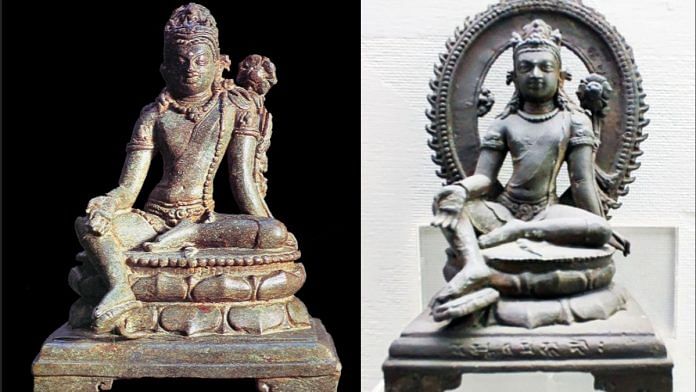New Delhi: Fourteen talks and nine flights in three weeks, Sri Lankan art historian, archaeologist and numismatist Osmund Bopearachchi is a busy man. Last week, he was at Delhi’s India International Centre, where he traced the journey of sea merchants and their role in advancing Buddhism in the ancient South Asian region. The audience — old and young — was captivated.
In his 45-minute presentation, Bopearachchi presented artefacts such as engraved marbles, stone relics, intricate sculptures and excavations from a shipwreck to illustrate the crucial role sea traders played in South Asia not just in exchanging goods, but also as mediators of cultural interactions.
Apart from traders, Buddhist monks and nuns, philosophers, artists, and diplomats who travelled across merchant networks also acted as cultural mediators. “As a result, not only goods but also philosophical thoughts, ideas, and artistic traditions were exchanged,” said Bopearachchi.
His lecture—Understanding the Ancient Indian Ocean Trade Through Buddhist Iconography—is the first in the series South Asia Beyond Borders co-organised by the IIC and Ashoka University. The lectures aim to highlight new discoveries and methodologies that are emerging within the history and archaeology of the region.
Also Read: Buddhism did not spread by the sword. But the empires that helped it grow did
Buddhism as a promoter of trade
During the lecture, sculptures from multiple South Asian countries were projected on the screen. The audience in the quiet lecture hall didn’t take their eyes off it as Bopearachchi pointed out the multiple minute similarities between the sculptures found in Sri Lanka, India and Indonesia.
Some of the archaeological artefacts he presented included an antelope’s head, balloon sleeves worn as dresses, a Sansanian-type wine jar and a plethora of coins, metals, ceramics and seals. Through it, he took the audience on the journey that the merchants of those times undertook. Bopearachchi concluded the showcase by saying that, “unlike Hinduism, Buddhism promoted trade”.
“Buddhism promoted itself as a promoter of trade. Buddhist communities were also established around trade routes, linking important political and economic centres,” he explained.
He added that the Buddhists invited donations from rich merchants. The merchants also patronised the building of monuments and spread Buddhism to wherever they travelled. This, he explained, is how the symbiotic relationship between the two grew.
Former foreign secretary and president of IIC, Shyam Saran who mediated the session reminisced about his time in the region as a diplomat.
“This is a subject very close to my heart. During my diplomatic career, I served in Myanmar, Indonesia, Nepal, China, and Japan. What really fascinated me is that in all these countries, you see the colours and echoes of India everywhere. To understand India’s own history, we need to see facets of our culture which lie embedded in other countries,” said Saran.
Also Read: Buddhists ran sophisticated medieval hospitals in Sri Lanka—heated pool, forceps, acupuncture
Shared cultural heritage
According to co-chair of the session, Upinder Singh, professor of history and dean of faculty at Ashoka University, the research into the sea traders also shows how the region has shared elements that connect the various countries that are today separated by national borders.
“His [Bopearachchi’s] work reminds us that the continent has always been a part of the larger wealth of interactions that extended beyond the Hindukush and Kanyakumari,” said Singh
Bopearachchi is emeritus director of research, French National Centre for Scientific Research (CNRS-ENS Paris), former adjunct professor of central and south Asian art, archaeology and numismatics, University of California, Berkeley and former visiting professor and member, Doctoral School of the Paris-Sorbonne University.
Bopearachchi who has conducted excavations in 29 countries, 16 published books, 148 research papers and much more under his belt, drew parallels between cave paintings in Sri Lanka to those found in Ajanta caves in Maharashtra and Nagarjunakonda in Andhra Pradesh.
These cultural and religious relations between Andhra Pradesh and Sri Lanka drew Buddhist communities closer together, he said.
“But what proof do you have that these sculptures are from India,” asked a member of the audience during a question and answer session.
Bopearachchi patiently explained that besides the stone type and iconographic similarities, Sri Lanka had very few sculptures so most of these were exported from India in those times.
“But wasn’t carrying the heavy sculptures all the way from Maharashtra and Andhra Pradesh to Sri Lanka a painful task,” the same person followed up.
“Sri Lanka exported elephants. 250 kgs of food per day were also sent per elephant. So, they were capable of transporting sculptures.”
(Edited by Theres Sudeep)



